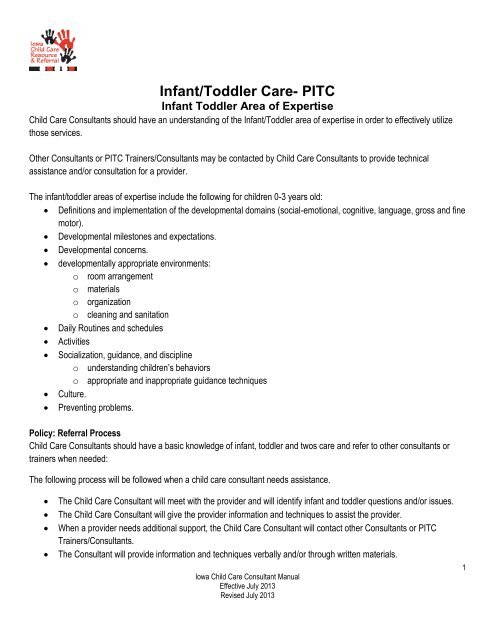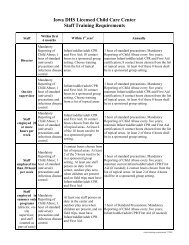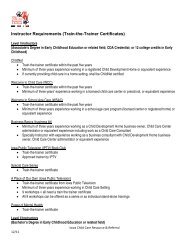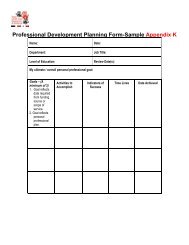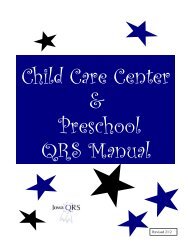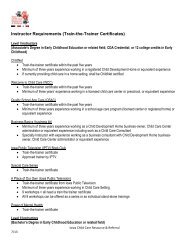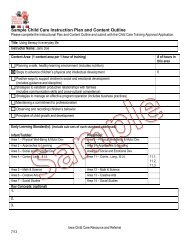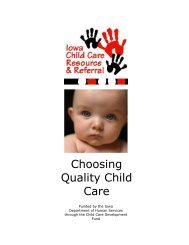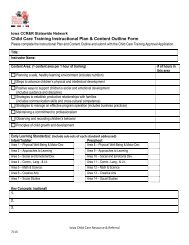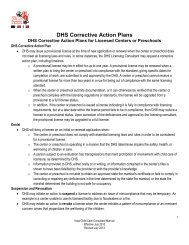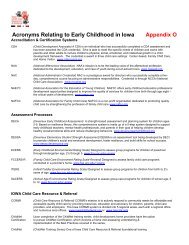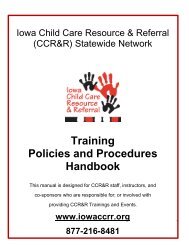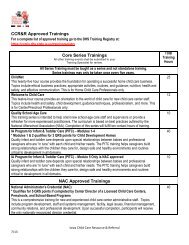Infant/Toddler Care- PITC - Iowa Child Care Resource & Referral
Infant/Toddler Care- PITC - Iowa Child Care Resource & Referral
Infant/Toddler Care- PITC - Iowa Child Care Resource & Referral
- No tags were found...
You also want an ePaper? Increase the reach of your titles
YUMPU automatically turns print PDFs into web optimized ePapers that Google loves.
<strong>Infant</strong>/<strong>Toddler</strong> <strong>Care</strong>- <strong>PITC</strong><strong>Infant</strong> <strong>Toddler</strong> Area of Expertise<strong>Child</strong> <strong>Care</strong> Consultants should have an understanding of the <strong>Infant</strong>/<strong>Toddler</strong> area of expertise in order to effectively utilizethose services.Other Consultants or <strong>PITC</strong> Trainers/Consultants may be contacted by <strong>Child</strong> <strong>Care</strong> Consultants to provide technicalassistance and/or consultation for a provider.The infant/toddler areas of expertise include the following for children 0-3 years old: Definitions and implementation of the developmental domains (social-emotional, cognitive, language, gross and finemotor). Developmental milestones and expectations. Developmental concerns. developmentally appropriate environments:o room arrangemento materialso organizationo cleaning and sanitation Daily Routines and schedules Activities Socialization, guidance, and disciplineo understanding children’s behaviorso appropriate and inappropriate guidance techniques Culture. Preventing problems.Policy: <strong>Referral</strong> Process<strong>Child</strong> <strong>Care</strong> Consultants should have a basic knowledge of infant, toddler and twos care and refer to other consultants ortrainers when needed:The following process will be followed when a child care consultant needs assistance.The <strong>Child</strong> <strong>Care</strong> Consultant will meet with the provider and will identify infant and toddler questions and/or issues.The <strong>Child</strong> <strong>Care</strong> Consultant will give the provider information and techniques to assist the provider.When a provider needs additional support, the <strong>Child</strong> <strong>Care</strong> Consultant will contact other Consultants or <strong>PITC</strong>Trainers/Consultants.The Consultant will provide information and techniques verbally and/or through written materials.<strong>Iowa</strong> <strong>Child</strong> <strong>Care</strong> Consultant ManualEffective July 2013Revised July 20131
The <strong>Child</strong> <strong>Care</strong> Consultant will continue to work with the provider using the information from the other Consultant.The <strong>Child</strong> <strong>Care</strong> Consultant will continue to follow up with the provider.Primary <strong>Care</strong> <strong>Child</strong> <strong>Care</strong> Consultants will encourage programs to implement Primary <strong>Care</strong>giving for children 0-3 years. A Primary <strong>Care</strong>giver:o Is assigned to a small group of children for a significant part of each child’s day in care. (A child shouldhave no more than two primary infant care teachers per day.)o <strong>Care</strong>s for the children during most of the routines of the day, including greetings, departures, feeding,diapering, napping, indoor and outdoor play, bathing and dressing, record keeping, and tracking eachchild’s development.o Builds a relationship through routines and other activities with each child.o Is the person the child turns to when in physical or emotional need?o Works closely with each child’s family to develop a partnership beginning at the time of enrollment.o Learns about the child’s care at home and provides information about the program.o Communicates with parents about the benefits of Primary <strong>Care</strong>.o Supports the child’s relationship with his or her family culture.o Shares information with the family on a daily basis, during regular parent conferences, and as needed.o Works as a team with another primary infant care teacher (or other infant care teachers).o Is the main resource and a member of a team with the family and other adults involved with the child, suchas other primary and secondary infant care teachers, the program manager, and specialists for a child withdisabilities or other special needs.Daily structure <strong>Child</strong> <strong>Care</strong> Consultants will review the daily schedule and plans in a child care program, ensuring that they create aresponsive environment for the children. Parts of a daily schedule include routines as well as play experiences including:o playing with toyso imitating and pretendingo enjoying stories and bookso connecting with musico creating with arto tasting and preparing foodo exploring sand and watero exploring outdoors An appropriate schedule should:o be flexible and adaptable<strong>Iowa</strong> <strong>Child</strong> <strong>Care</strong> Consultant ManualEffective July 2013Revised July 20132
o be individualizedo be child-directedo allow sufficient time for routines, play experiences, and transitionso have active and quiet timeso provide opportunities for children to be alone and spend time in small groupso include outdoor playThe daily schedule of infants is different than the daily schedule of toddlers and twos:o <strong>Infant</strong>s follow an on-demand schedule for feeding, diapering, sleeping and playing.o <strong>Toddler</strong>s and twos have a more consistent and group-oriented schedule. Group times are short,developmentally appropriate, and children may leave if they wish.Transitions are the periods between one routine or experience and the next. Ideas to prepare for transitions are:o plan aheado be organizedo give children a warningo give clear directionso avoid having children waito guide children through transitions<strong>Care</strong>giving Routines/Routines as Curriculum<strong>Child</strong> <strong>Care</strong> Consultants should be aware of the importance of caregiving routines and the impact they have on children.When in a child care program, <strong>Child</strong> <strong>Care</strong> Consultants should observe how routines are handled. <strong>Care</strong>giving routines take up to 80 percent of a provider’s time and they are a major part of the curriculum forchildren. During routines, children have the opportunity to learn:o security and self-esteemo pleasure and tactile stimulationo a sense of time, space and rhythmso independence and competenceo cognitive and language skills <strong>Care</strong>giver routines in a child care program include:o greetings and departureso diapering and toiletingo hand washingo eating and mealtimeso sleeping and nap timeso getting dressed and bathing Environmental considerations for routines include:<strong>Iowa</strong> <strong>Child</strong> <strong>Care</strong> Consultant ManualEffective July 2013Revised July 20133
o similarity to the home settingo warmth and friendliness to familieso defined space for each routineGuidance and Discipline<strong>Child</strong> <strong>Care</strong> Consultants will role model and teach providers appropriate guidance techniques and be able to recognizeinappropriate guidance techniques. Appropriate guidance techniques for infants, toddlers and twos include the following:o Offer praise throughout the day.o Always model the appropriate behavior.o Redirect the child to another activity.o Give words for the child to express his feelings.o Use do’s instead of don’ts.o Offer choices.o Firmly state what you want the child to do at eye level.o Connect the behavior to the consequence.o Acknowledge the child’s feelings.o Implement cool-down time. Inappropriate guidance techniques for infants, toddler and twos include the following:o Physical harm to a child.o Shame or humiliation.o Saying “bad boy” or “bad girl” (or “naughty boy or girl”).o Using false threats or choices.o Bribing the child.o Using food or activities as punishment.o Making the child say “sorry”.o Time-out.Biting<strong>Child</strong> <strong>Care</strong> Consultants will address biting issues in a child care program through observations and consultation. In child care center settings, a written biting policy is required by <strong>Iowa</strong> Department of Human Services. The policyis meant to assist programs in responding to biting incidents in a positive manner and promote better outcomeswhen biting occurs.o Consultants will use the Response to Biting Policy <strong>Resource</strong> to assist centers in developing its policy. It is important that providers understand why biting occurs and then work to decrease the number of incidents.Biting may occur because children:o Are not provided developmentally appropriate care and guidance.<strong>Iowa</strong> <strong>Child</strong> <strong>Care</strong> Consultant ManualEffective July 2013Revised July 20134
o Do not have a strong attachment with a consistent, responsive caregiver.o Have too many transitions throughout the day.o Are cared for in large groups (maximum of 8 is recommended).o Are in large/undefined spaces.o Lack the language skills necessary for expressing needs or strong feelings.o Are overwhelmed by the sounds, light or activity level in the setting.o Are experimenting to see what will happen.o Need more active playtime, choices, and access to materials.o Are overtired.o Are teething.o Have a need for oral stimulation.Documentation of biting incidents may benefit providers in recognizing a pattern in a child’s biting behavior. Thefollowing should be documented.o Where did the biting happen?o Who was involved?o When did the biting happen?o What happened before the biting happened?o What happened after the biting happened? How was the situation handled?Physical Environment<strong>Child</strong> <strong>Care</strong> Consultants will assist infant and toddler providers in creating responsive and developmentally appropriatephysical environments. The following lists some of the characteristics of an appropriate environment for infants, toddlers and twos.o <strong>Child</strong>-sized furnitureo Low, open shelveso Containers labeled with pictures and wordso Accessibility to toys and materialso Comfortable seating for adultso Variety of surfaces, such as carpet, rugs, vinyl, etc.o Active and quiet areas are located away from each othero Messy areas are near a sinko Multiple levelso Defined interest areas• Books• Music• Fine Motor• Gross Motor• Dramatic Play• Blocks• Art<strong>Iowa</strong> <strong>Child</strong> <strong>Care</strong> Consultant ManualEffective July 2013Revised July 20135
• Sensoryo Non-mobile area with barrierso Cozy areao Photographs displayed at eye level of childreno Variety of toyso Multiples of favorite toyso Mirrors at eye levelo Materials that promote diversity<strong>Resource</strong>s:1. <strong>Infant</strong>/<strong>Toddler</strong> Environment Rating Scale, Revised Edition. 2003.2. Family <strong>Child</strong> <strong>Care</strong> Environment Rating Scale, Revised Edition. 2007.3. The Program for <strong>Infant</strong> <strong>Toddler</strong> <strong>Care</strong>givers. West Ed.4. The Creative Curriculum® for <strong>Infant</strong>s, <strong>Toddler</strong>s and Twos, Second Edition, Revised 20115. The Program for <strong>Infant</strong> <strong>Toddler</strong> <strong>Care</strong>, A Guide to Routines, Second Edition. West Ed. Sacramento, 2002.<strong>Iowa</strong> <strong>Child</strong> <strong>Care</strong> Consultant ManualEffective July 2013Revised July 20136


